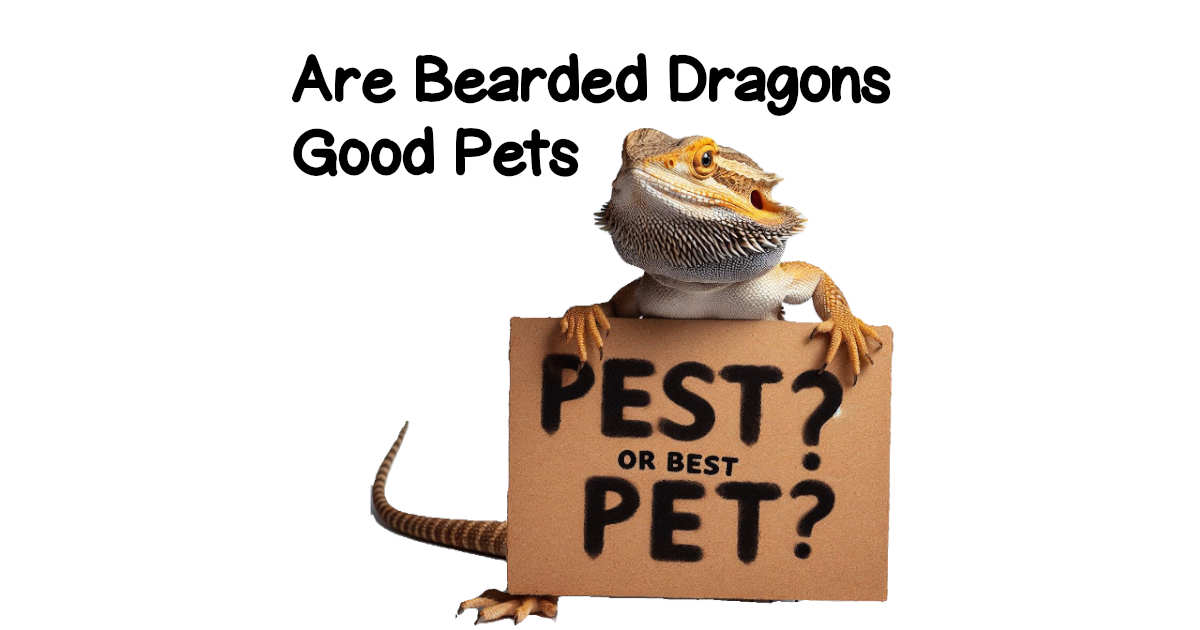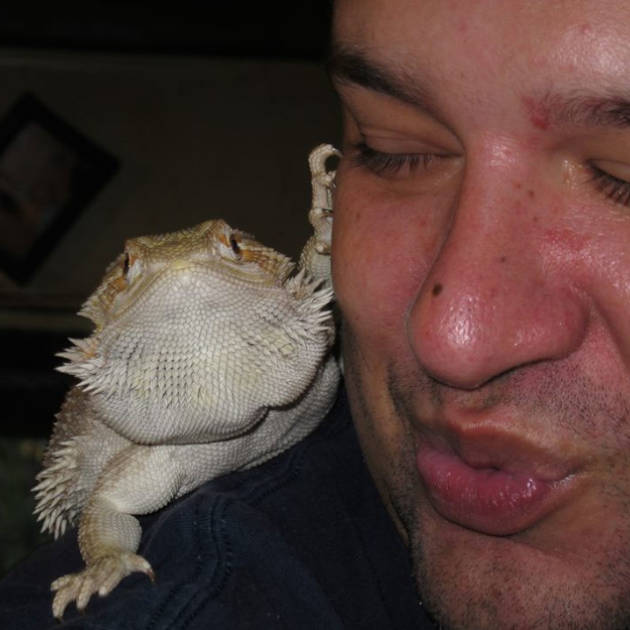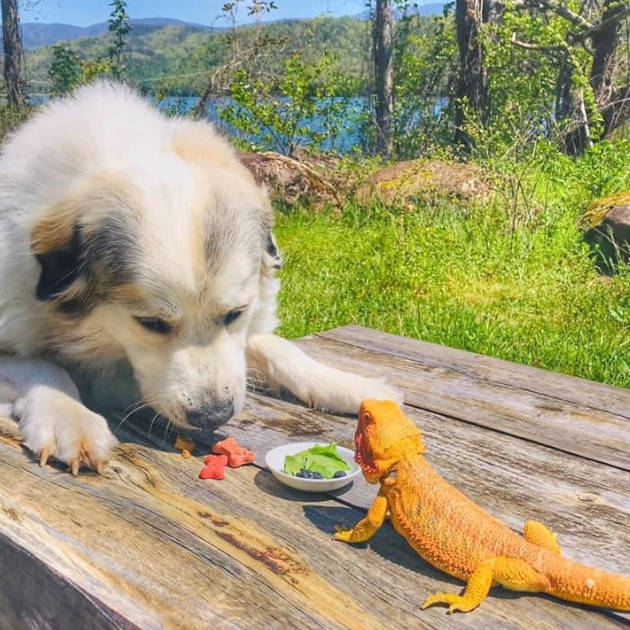Bearded dragons are a very common reptile pet but are bearded dragons good pets? Bearded dragons are requently hailed as one of the best reptilian pets, especially for first-time reptile owners. Their manageable size and straightforward care routines make for a variety of pet lovers, from beginners to seasoned enthusiasts.
Are bearded dragons exotic pets? Indeed, bearded dragons are exotic pets hailing from Australia’s rich landscapes. These reptiles can bring a touch of the exotic into your home with their unique charm.
Are bearded dragons friendly to humans? Absolutely bearded dragons are friendly to humans, with some exceptions. These typically gentle creatures enjoy human interaction and can develop deep bonds with their caregivers. Their friendly demeanor makes them wonderful companions, especially in homes with children. Yet, getting to know their dietary, environmental, and social needs is key to fostering a thriving relationship.
For those just starting their pet journey, are bearded dragons good pets for beginners? Yes, bearded dragons can be good pets for beginners prepared for the learning curve. Bearded dragons are known for being less demanding than other reptiles once their habitat is properly set up, however knowledge is required to do that properly.
Interacting with your bearded dragon can positively affect their behavior, suggesting that they thrive on attention and care. Embracing the responsibility that comes with a bearded dragon means creating a nurturing environment and staying attuned to their health and well-being.
Are bearded dragons good pets for you? Although they are generally hardy, bearded dragons have unique needs that, when not met, can lead to health issues. It’s worth noting that caring for pet reptiles like bearded dragons can sometimes be tricky, especially if it’s your first time. They have specific needs that are a bit different from your typical pets, and it’s easy to get things mixed up without the right information. In fact, a study found that a lot of reptile owners run into unexpected challenges. These can range from not catching on to signs that their pet isn’t feeling well, to not fully understanding how tough their little buddies are, or even getting a bit confused about how to set up their living space just right (Stockley, Wilkinson & Burman, 2020). It’s all part of the learning curve, and getting familiar with their unique needs is key to a happy and healthy bearded dragon.

Jump To…
Why Bearded Dragons Are Considered Good Pets
Bearded dragons are renowned for their endearing temperament and ease of care, making them excellent pets for both novice and experienced lizard enthusiasts.
Friendly and Docile Nature
Bearded dragons exhibit a docile and friendly demeanor that differentiates them from many other reptiles. They are naturally social creatures, often showing signs of recognition and bonding with their owners. This friendly nature allows for regular handling, as they are generally calm and tolerant of human interaction, which contributes to their reputation as great pets.
How Long Do Bearded Dragons Live For?
How long bearded dragons live for is variable dependent on numerous factors, particularly the quality of care they are given. The typical lifespan of bearded dragons, considered a good pet choice, ranges from 10 to 15 years. Nevertheless, with exceptional care, some bearded dragons can surpass this, living up to 20 years. The longevity of these reptiles, known for being good pets, is greatly influenced by factors like diet, habitat, and comprehensive health care.
With a significant lifespan owners can develop a deep bond with their bearded dragon, building mutual trust and familiarity. The potential for such a long-term relationship adds to their appeal, making them companions that can be a part of their owners’ lives for many years.
Safety and Suitability of Bearded Dragons as Pets
Choosing a pet is a deeply personal decision, influenced by your lifestyle, household environment, and emotional connection with the animal. If you’re contemplating “are bearded dragons good pets” for you, it’s essential to consider both the unique qualities they bring to a home and the responsibilities they entail.
Evaluating Safety and Compatibility
“Are bearded dragons good pets?” is a question that often arises due to their gentle nature, making them a great companion in many households. They are typically docile which creates a lower risk of aggressive behavior, offering a sense of safety and ease for families considering a reptilian pet.
However, safety extends beyond temperament; it’s also about mitigating health risks. Bearded dragons, like all reptiles, can carry Salmonella, a concern that can be managed with diligent hygiene practices. Washing hands after interaction and maintaining a clean habitat are simple yet effective steps to safeguard your household’s health.
Is a Bearded Dragon Right for Your Family?
When pondering “are bearded dragons good pets” for your family, consider that involving one of these reptiles in your family comes with a set of responsibilities that can be both rewarding and demanding. Their care, while not overly complicated, requires a commitment to regular feeding, habitat maintenance, and health monitoring. For those seeking a pet that offers both companionship and the opportunity to learn about reptile care, a bearded dragon can be a fulfilling choice. Yet, it’s crucial that every family member is on board, understanding the care needs and comfortable with the level of interaction a bearded dragon offers.
Weighing the Emotional Connection
Pets are more than just animals in our care; they are companions that we bond with on an emotional level. Bearded dragons have a unique way of interacting with their owners, from recognizing their presence to showing contentment during gentle handling. If you’re drawn to the idea of nurturing this kind of unique bond and are intrigued by the serene yet engaging presence of a bearded dragon, this could be a sign that they might fit well into your life.
In making your decision, consider not just the practical aspects of care, but also the emotional resonance you feel with bearded dragons. Every pet relationship is unique, and the best choices are made when we align our needs and capacities with the needs and nature of the pet we wish to bring into our lives. Whether a bearded dragon is the right pet for you hinges on a blend of safety considerations, suitability for your living situation, and the emotional fulfillment you seek in a pet. “Are bearded dragons good pets?” Ultimately, this question can only be answered by carefully considering your personal circumstances and connection to these unique reptiles.
Considering Bearded Dragons as Pets: Points to Ponder
Are bearded dragons good pets? Even though they have a friendly nature and manageable care, there are some other important considerations to keep in mind:
- Getting Started:
- Be ready for the initial costs, including a cozy bearded dragon enclosure, special UVB lighting, and a climate control system to make your bearded dragon feel at home.
- Health Matters:
- Keep an eye out for signs of zoonotic disease. Salmonella is a common concern with reptiles, to keep everyone at home safe and healthy.
- A varied and balanced diet is key to avoiding nutritional issues.
- Regular check-ins with a vet who knows their way around reptiles will keep your dragon in top shape.
- Day-to-Day Care:
- Daily tasks like feeding, cleaning, and spending time together are part of the journey.
- Remember, you’re in it for the long haul, with bearded dragons living 10-15 years or more.
- Gentle and patient interactions will keep stress at bay and build a strong bond.
- Your Space and Theirs:
- Make sure you have enough room for a spacious enclosure.
- Be mindful of potential allergies, both to their food and possibly the dragons themselves.
- Expect your utility bills to go up a bit due to their heating and lighting needs.
- Keeping their home clean is essential for their health and your comfort.
- The Bigger Picture:
- Look into local pet ownership laws to make sure you’re all set.
- Choosing a bearded dragon that’s been bred in a responsible, ethical way.
- Social Life and Well-Being:
- Understand their unique social cues and how they prefer to interact.
- Regular, gentle handling and engagement will keep them mentally stimulated and content.
- Comforts of Home:
- A well-maintained environment with the right temperature and humidity makes all the difference.
- UVB lighting is non-negotiable for their health, so make sure it’s set up correctly and replaced as needed.
- Make their habitat escape-proof to avoid any unexpected adventures.
- Enriching Experiences:
- Deck out their space with substrates, cozy hiding spots, abrasive surfaces, rocks, and places to climb for a stimulating environment.
- Breeding and Beyond:
- If you’re thinking about breeding, it’s a whole other ball game with its own set of challenges and responsibilities.
- Stay informed about common diseases and how to prevent them to keep your dragon healthy.
- Feeding Finesse:
- Mix up their diet and keep those supplements coming to meet all their nutritional needs.
- Understanding Their Language:
- Keep an eye out for behavioral cues that tell you how they’re feeling, and learn when it’s time to visit the vet.
- Life Stages:
- Cater to their changing needs as they grow from juveniles to adults, and eventually, seniors.
- Household Harmony:
- Make sure any interactions with other pets are safe and stress-free for everyone involved.
- Ready for Anything:
- Have a plan in place for emergencies to ensure their environment stays just right, even during a power outage.
- Green Living:
- Embrace sustainable pet care practices to make a positive impact on the planet.
- Community Connection:
- Dive into the world of bearded dragon enthusiasts for support, tips, and friendship.
- The Final Chapter:
- Consider the emotional and practical aspects of end-of-life care, ensuring you’re prepared for tough decisions down the road.
- Financial Planning:
- Budget not just for the initial setup but also for ongoing and potential long-term health care needs.
These details highlight why thorough research and consideration are necessary before deciding to bring a bearded dragon into your home. There are many factors to consider ensuring the well-being of both the pet and the owner.
Bearded Dragons: Ideal Companions for Beginners and Families
Are bearded dragons good pets for beginners? Bearded dragons are typically considered as good reptilian pets. Their manageable size and relatively straightforward care requirements make bearded dragons not only good pets but also particularly suitable for first-time reptile owners.
Why Are Bearded Dragons Good Pets? One of the key reasons bearded dragons are considered good pets is their docile temperament and responsiveness to human interaction. These friendly reptiles often form strong attachments with their owners, showcasing behaviors that indicate a genuine enjoyment of human company. This friendly nature makes bearded dragons safe pets, particularly in households with children, as they pose minimal risk of aggressive behavior.
Are Bearded Dragons Friendly to Humans? Absolutely. The friendly demeanor of bearded dragons differentiates them from many other reptiles. They are known for their social nature, often showing signs of recognition and bonding with their caretakers. This aspect contributes significantly to the question of what makes bearded dragons good pets, as their interaction can enrich the pet ownership experience, offering companionship and a fascinating insight into reptilian behavior.
Ease of Care and Beginner Suitability “Are bearded dragons easy pets?” Compared to other exotic pets, bearded dragons they are one of the easier reptiles. The learning curve for their care is manageable and rewarding. Their dietary needs are consist of a mix of insects and vegetables, and their habitat requirements, while specific, are easy to maintain once properly set up. These factors contribute to their reputation as good first pets, providing a fulfilling experience for those new to pet care without the overwhelming responsibilities that more demanding pets might require.
In considering “Are bearded dragons good pets?”, it’s essential to weigh these aspects against your personal circumstances and readiness to commit to their care. With the right approach, a bearded dragon can indeed be a delightful addition to your home, offering a unique blend of companionship and interactive engagement that many pet owners seek.
Kids want a Bearded Dragon, Key Considerations for Parents
Are bearded dragons good pets for kids? If your child is keen on welcoming a bearded dragon into your home, it’s a wonderful opportunity to embark on an educational journey together. Here are some suggestions to ensure a joyful and enriching experience for your family and the new scaly friend.
Guidance and Learning Together:
- Together Time: It’s great to share the experience with your child, guiding them through gentle interactions with the bearded dragon to foster a caring and respectful relationship.
- Learning as a Family: Discovering more about bearded dragons can be a fun family activity, helping everyone understand how to best care for your new pet.
- Learning Budgeting: Introducing a bearded dragon to the family can serve as a practical lesson in budgeting. Allowing children to manage a specified budget for their pet’s needs, such as food, supplies, and potential vet visits, can teach valuable financial management skills and foster a deeper understanding of the ongoing commitments involved in pet care.
Encouraging Your Child’s Involvement:
- Soft Touch: Gently showing your child how to handle the bearded dragon can help minimize stress for the pet and make handling time enjoyable for everyone.
- Understanding Boundaries: It’s helpful to teach your child to notice when their pet needs some quiet time, ensuring a comfortable environment for the bearded dragon.
- Care Contributions: Getting your child involved in simple habitat maintenance tasks can be a great way for them to learn responsibility and take pride in caring for their pet.
Thinking About the Budget:
- Setting Up Home: Creating a cozy and suitable home for your bearded dragon is the first step. It’s worth considering the initial costs to make sure your pet feels right at home.
- Daily Care: Planning for the day-to-day needs like food and supplements can be part of your family budgeting, making it a good learning opportunity about financial planning.
- Healthcare for Your Pet: Occasional visits to the vet are part of keeping your bearded dragon healthy. It’s good to be prepared for these visits to keep your pet in tip-top shape.
Health and Well-being:
- Staying Healthy Together: Keeping in mind that bearded dragons can carry Salmonella, it’s wise to practice good handwashing after pet interactions, protecting your family’s health.
- Happy Pet, Happy Family: Noticing how your bearded dragon is feeling and ensuring they’re comfortable and stress-free contributes to a harmonious family environment.
Considering these aspects thoughtfully, you can make a well-informed decision about adding a bearded dragon to your family. It’s all about creating a positive environment where both your child and their new pet can thrive together, reflecting on whether are bearded dragons good pets for your family’s lifestyle.
Are Bearded Dragons Good Pets for 9 Year Olds?
When evaluating if are bearded dragons good pets for 9 year olds, consider the various aspects that contribute to a positive experience for both the child and the pet.
Are bearded dragons good pets for 9 year olds key considerations:
- Bearded Dragon Behavior: Bearded dragons are known for their docile nature, making them potential candidates for younger pet enthusiasts with proper adult supervision.
- Maturity and Responsibility: At 9 years old, children are developing the ability to follow more complex instructions and understand the consequences of their actions. This age can be suitable for introducing the concepts of pet care responsibility.
- Supervised Interaction: Ensuring safe and respectful interactions between the child and the bearded dragon is essential. Supervision by an adult during handling and care activities helps prevent accidental stress or harm to the pet.
- Educational Opportunity: Caring for a bearded dragon can teach a 9-year-old about empathy, biology, and the responsibilities involved in caring for another living being. It’s an engaging way to introduce concepts of daily commitment and the needs of pets.
- Handling and Care: Gentle handling techniques should be taught to ensure the safety of both the child and the bearded dragon. Learning to recognize the bearded dragon’s comfort and stress signals can foster a respectful relationship.
Are bearded dragons good pets for 9 year olds? With the right guidance from adults and a genuine interest from the child, bearded dragons can serve as wonderful companions that offer valuable life lessons. However, the ultimate responsibility for the bearded dragon’s well-being rests with the adults in the household, ensuring a healthy and nurturing environment for the pet.
Are Bearded Dragons Good Pets for a 10 Year Old?
Delving into whether are bearded dragons good pets for 10 year olds requires a look at whether these reptiles are well-suited companions for children who are a decade old.
Are bearded dragons good pets for a 10 year old key considerations:
- Growing Independence: At the age of 10, children often exhibit a higher degree of independence and capability to undertake small responsibilities. This makes it a suitable time to introduce the concept of pet care with adult oversight.
- Engagement and Learning: Caring for a bearded dragon provides a hands-on learning experience about reptile behavior, habitat needs, and nutrition, fostering a sense of curiosity and respect for living creatures.
- Supervised Care: While a 10-year-old can participate in many aspects of pet care, adult supervision is crucial to ensure the well-being of both the child and the bearded dragon. It’s important that adults handle the primary responsibilities and more complex tasks.
- Safety and Interaction: Teaching proper handling techniques is essential to ensure the safety of the bearded dragon. Children should learn how to interact gently with the pet, recognizing signs of stress or discomfort.
Are bearded dragons good pets for 10 year olds? With an appropriate level of adult support and supervision, bearded dragons can indeed be good pets that contribute positively to a child’s development. They offer an opportunity for 10-year-olds to learn about responsibility, empathy, and the natural world in a direct and engaging manner. However, it’s important to gauge the child’s interest and commitment to ensure a fulfilling experience for both the pet and the young caretaker.
Are Bearded Dragons Good Pets for Teenagers?
Bearded dragons, with their distinct personalities and care requirements, can indeed align well with the interests and capabilities of teenagers, fostering a rewarding companionship.
Are bearded dragons good pets for teenagers key considerations:
- Responsibility and Learning: The daily care routines for a bearded dragon, such as feeding, habitat cleaning, and health monitoring, teach teenagers valuable lessons in responsibility. This hands-on care provides an educational glimpse into the needs and behaviors of reptiles, enriching a teenager’s understanding of biology and pet care.
- Compatibility with Teenage Lifestyle: The relatively low-maintenance nature of bearded dragons, coupled with their interactive behavior, makes them well-suited to a teenager’s lifestyle. The opportunity for bonding, through activities like handling and watching their natural behaviors, offers a unique form of companionship that can be particularly comforting during the often tumultuous teenage years.
- Long-Term Commitment: When considering are bearded dragons good pets for teenagers, it’s crucial to discuss the long-term commitment they entail. With a lifespan potentially extending beyond 15 years with proper care, a bearded dragon can be a long-term companion, requiring a sustained commitment that extends into a teenager’s young adult life.
Planning for the Future: As teenagers grow and their life circumstances evolve, plans for the continued care of the bearded dragon need to be considered. Whether it’s heading to college, starting a career, or moving out, the question of “are bearded dragons good pets for teenagers” should include a discussion about the future care of the pet. Ensuring there’s a plan in place for the bearded dragon’s welfare during these transitions is essential for responsible pet ownership.
In conclusion, are bearded dragons good pets for teenagers? Yes, they can be, provided there’s an understanding of the responsibilities involved, a commitment to long-term care, and a plan for the pet’s future. Bearded dragons offer a unique opportunity for teenagers to learn about and engage with the natural world, developing a sense of responsibility and empathy that can be invaluable in their personal growth.
Are Bearded Dragons Good Pets Around Babies?
Bearded dragons can be kept as pets in households with babies, but there are important considerations to keep in mind, particularly regarding health and safety.
Firstly, bearded dragons, like many reptiles, can carry zoonotic diseases. For example, Salmonella, a bacteria that poses a significant risk to babies who have weaker immune systems. Salmonella can cause serious illness in infants, leading to symptoms like diarrhea, fever, and abdominal cramps.
To manage this risk, it’s crucial to practice good hygiene. This includes washing hands thoroughly with soap and water after handling the bearded dragon or its habitat. It’s also important to avoid letting the reptile roam freely, especially in areas where the baby spends time.
In terms of direct interaction, there are risks involved with babies and bearded dragons being in close contact. While bearded dragons are generally docile, they can scratch or bite if frightened or mishandled, which could be more dangerous for a baby. Moreover, babies are naturally curious and may inadvertently harm the reptile, leading to stress or injury for the bearded dragon.
In summary, “are bearded dragons good pets around babies”, while bearded dragons can be in the same household as babies, strict hygiene practices should be followed to minimize the risk of Salmonella and other zoonotic diseases. It’s also advisable to keep the bearded dragon and baby separate to prevent any physical harm to either. Careful supervision and proper management can mitigate these risks, but the safety and health of both the baby and the pet should always be a priority.
What Type of Bearded Dragon is the Best Pet?
When selecting a bearded dragon as a pet, consider the species and morph that best suits your needs and lifestyle. Bearded dragons offer a variety of species and morphs, each with its own unique characteristics.
The term ‘species’ refers to the different types of bearded dragons found in the wild, primarily differentiated by their natural habitats and physical traits. For example, the most common species in the pet trade is the Central Bearded Dragon (Pogona vitticeps), known for its adaptability and friendly nature.
On the other hand, bearded dragon ‘morphs’ are variations within a species, created through selective breeding to enhance certain physical traits like color, pattern, or scale texture.
These morphs, such as ‘leatherback’ or ‘silkback’, offer a diverse range of appearances, but generally do not differ significantly in care requirements from the standard form of the species.
However, some morphs may require special attention due to unique features, such as more sensitive skin in silkback morphs. Therefore, when choosing a bearded dragon, it’s important to understand both the natural characteristics of the species and the specific needs associated with the chosen morph.
What is the Best Bearded Dragon Species to Own?
The Central Bearded Dragon (Pogona vitticeps) stands out as the most commonly recommended species for pet owners. They are known for their docile temperament and ease of handling, making them particularly suitable for beginners. The manageable size of Central Bearded Dragons, typically reaching up to 24 inches (60cm) in length, contributes to their popularity among reptile enthusiasts.
However, the best bearded dragon species also depends on the country and specific region you live in. For instance, in Australia where bearded dragons originate from, the laws regarding pet reptiles vary by state. Residents are only permitted to keep species of bearded dragons that naturally occur in their state.
This means that while the Central Bearded Dragon is a popular choice globally, Australians need to consider the local species available to them, adhering to regional wildlife and pet ownership regulations.
For example, in Western Australia residents of the state can only keep the Pogona minor minor, also known as the Western Bearded Dragon or Dwarf Bearded Dragon.
Therefore, when deciding on the best bearded dragon species to own, it’s essential to not only consider the characteristics and care needs of the species but also to be aware of and comply with local wildlife laws and regulations.
What Bearded Dragon Morphs Are There?
Bearded dragon morphs are the result of selective breeding, and they exhibit a range of colors, patterns, and scalation. Some recognizable morphs include:
- Standard: The natural appearance of bearded dragons, with earthy tones.
- Hypomelanistic: These have reduced dark pigmentation, displaying brighter colors.
- Translucent: Characterized by semi-transparent scales, giving a unique, almost ethereal look.
- Leatherback: This morph has smoother skin with smaller scales, reducing the spikiness on their back.
- Silkback: Silkbacks are scaleless, offering a completely smooth appearance.
Each morph can have specific care requirements and aesthetic appeal. The Bearded Dragon Morphs guide offers comprehensive insight into the multitude of morphs available, which can cater to a range of preferences and interests for prospective bearded dragon owners.
Are Geckos or Bearded Dragons Better Pets?
Whether geckos or bearded dragons better pets largely depends on individual preferences, lifestyle, and the level of care each owner is prepared to offer.
Bearded Dragons: Known for their docile nature and responsiveness to human interaction, bearded dragons are often favored for their ease of handling and sociable behavior. They require a relatively large enclosure to accommodate their size and need for physical activity, along with specific heating, lighting, and dietary requirements. Their larger size compared to most geckos means they often require more space and food, but it also allows for a more interactive experience for the owner.
Geckos: Geckos, particularly the popular leopard geckos, are smaller and might be considered easier to house due to their smaller size. They are nocturnal, which could suit owners who are more active in the evenings. Geckos generally have simpler dietary needs, often thriving on a diet of insects without the need for the varied diet that bearded dragons require. However, their nocturnal nature might mean less interaction time for owners who are away during the day.
Are geckos or bearded dragons better pets:
- Consider your living space
- The time you can dedicate to care and interaction, and
- What you seek in a pet.
If you’re looking for a more interactive pet and have the space to accommodate a larger enclosure, a bearded dragon might be the better choice. On the other hand, if you prefer a smaller pet with simpler care requirements and are okay with less interaction, a gecko might be more suitable.
Ultimately, both bearded dragons and geckos can make wonderful pets, but their care requirements and the interaction they offer differ significantly.
Understanding Bearded Dragon Behavior and Temperament
Bearded dragons are often lauded for their docile nature, which makes them suitable companions for reptile enthusiasts. They possess a temperament that can facilitate bonding with their owners through regular, gentle handling, establishing a foundation of trust.
Do Bearded Dragons Like to Cuddle?
Bearded dragons do not “cuddle” in the typical sense as mammals do, but they are sentient beings with feelings. They are typically tolerant of handling and may exhibit a disposition that could be interpreted as enjoyment of close interaction.
These reptiles can show signs of stress if they are not accustomed to handling, so it’s imperative to approach interaction with patience and allow the bearded dragon to become comfortable with their owner’s presence.
- Trust-building: Starting with short handling sessions can help to build trust.
- Stress Signs: Watch for signs of discomfort such as hissing or trying to escape.

11 Things To Do with a Bearded Dragon Pet
Are bearded dragons good pets for fun? Interaction with a bearded dragon can take various forms, depending on the animal’s temperament and the owner’s commitment to creating a bond. A bearded dragon that’s easy to handle can participate in activities that both enrich its life and provide entertainment for the owner.
- Handling: They can be gently handled and allowed to sit comfortably on their owner’s lap or shoulder.
- Exploration: Allowing a bearded dragon to explore a safe, enclosed space outside their enclosure can be beneficial.
- Feeding Time: Hand-feeding can reinforce positive associations with the owner.
- Training: Bearded dragons can be trained to respond to their name, come when called, or even do simple tricks. This requires patience and consistent, positive reinforcement.
- Basking Together: Spend time with your bearded dragon while they bask under their heat lamp. This can be a quiet time for bonding, as basking is a crucial part of their daily routine.
- Swimming Sessions: Some bearded dragons enjoy swim time in a shallow pool or lukewarm bath. This can be both a fun activity and helpful for their hygiene.
- Interactive Play: Engage in interactive play using safe toys, like soft balls or objects they can push around. This can help in stimulating their mind and keeping them active.
- Photo Sessions: Have fun photo sessions with your bearded dragon, dressing them up in safe, comfortable reptile-friendly costumes or setting up themed photoshoots.
- Watching TV Together: Some owners find that their bearded dragons seem to enjoy watching television with them. This can be a relaxing way to spend time together.
- Outdoor Time: If the weather is appropriate, taking your bearded dragon outside for natural sunlight can be beneficial. Ensure it’s a safe, enclosed area and monitor them closely.
- Socialization: Introduce your bearded dragon to new people or other household pets, if it’s safe to do so. This should be done gradually and under close supervision and monitoring for stress.
It is crucial to monitor any bearded dragon during these activities for signs of stress or fatigue, ensuring that the experiences remain positive for the animal. Regular and respectful interaction can help foster a docile and content bearded dragon, enhancing the pet-owner relationship.

Basic Start Up & Care For A Pet Bearded Dragon
What do Bearded Dragons Eat?
Bearded Dragons are omnivores, meaning they enjoy a varied diet of both plants and protein sources. Their dietary needs change as they transition from juvenility to adulthood, with younger dragons requiring more protein.
Protein sources for Bearded Dragons include:
- Live insects: mostly crickets, roaches, and worms (like silkworms and waxworms).
- Occasionally small mice (pinky mice for larger dragons).
It is important these live foods are gut-loaded (fed nutritious foods) to ensure the dragon gets the necessary nutrients.
Plant sources should consist of:
- Leafy greens: collard greens, dandelion greens, and mustard greens.
- Vegetables: squash, bell peppers, and sweet potatoes.
- Fruits: apples, bananas, and berries (should be given sparingly due to sugar content).
Adult Bearded Dragons’ diet should be about 80% plants and 20% protein, while juveniles require more protein for growth.
Feeding tips:
- A variety of food is key for balanced nutrition.
- Dust the live food with a calcium supplement to prevent metabolic bone disease.
- The size of live prey should not exceed the space between the dragon’s eyes to prevent choking.
Understanding the correct diet is crucial in keeping a Bearded Dragon healthy. A well-balanced diet contributes to their health and well-being, establishing them as good pets for those committed to their proper care.
Initial Setup and Ongoing Expenses
The initial cost of purchasing a bearded dragon itself can be moderate; however, creating the right environment will incur additional expenses.
A proper tank is necessary, and it can be expensive, as bearded dragons require a sizable enclosure for ample movement.
Along with the tank, lighting and heating systems are essential to mimic their natural habitat, which can add to the upfront costs.
Substrates for the bottom of the tank are an ongoing purchase, depending on the chosen type.
Budgets also need to be set for ongoing expenses such as food, which includes live insects and fresh vegetables, and regular substrate replacement.
Equipment and Habitat
Providing a suitable habitat is critical for a bearded dragon’s health and happiness. A minimum 40-gallon tank is recommended for a single adult bearded dragon.
Inside the habitat, UVB lighting is crucial for the synthesis of vitamin D and calcium metabolism, while basking lamps ensure proper temperature gradients. Thermometers and hygrometers help monitor these conditions. The choice of substrate is also an important consideration for both comfort and ease of cleaning.
The Daily Routine of Bearded Dragon Care
Daily care for a bearded dragon requires a consistent time commitment. Owners need to spend time feeding the reptile a diet of live prey and vegetables, ensuring fresh water is always available, and managing the habitat’s temperature and humidity. Regular cleaning of the tank is necessary to maintain a healthy environment, including daily spot cleanings and more thorough weekly cleanings. Time must also be set aside for handling and socialization, as bearded dragons typically enjoy interaction with their owners.
Health and Veterinary Care
Bearded dragons require regular health checks and veterinary care. Familiarizing oneself with common health issues such as metabolic bone disease is crucial for early detection and treatment. Veterinary visits for routine check-ups or unexpected health problems can be costly, and owners should be prepared for this possibility. In addition, bearded dragons may need vitamin and mineral supplements, which adds to the cost of maintaining their health.
Prospective owners can find detailed care requirements by researching credible guidelines on how to cater to the specific needs of bearded dragons.
Adoption and Ethical Considerations
When considering adding a bearded dragon to the family, potential owners should navigate the ethical implications of pet ownership and the choice between purchasing from breeders or opting for adoption.
Choosing a Responsible Breeder or Adoption Service
Ethical Concerns: Ethical considerations play a key role when deciding where to obtain a bearded dragon. Prospective owners should ensure that they are supporting practices that prioritize the welfare of their pet. Choosing a responsible breeder or adoption service means verifying that the bearded dragons are captive-bred rather than taken from the wild, as wild-caught animals may contribute to ecological imbalance and suffer from stress related to captivity.
Ownership Responsibility: Whether one decides to adopt or purchase a bearded dragon, it is crucial to recognize the commitment of bearded dragon ownership. These pets require specific conditions to thrive, including proper temperature regulation, a varied diet, and enough space to exhibit natural behaviors.
Family Considerations: Families should consider how a bearded dragon will fit into their household. These reptiles can live for several years, and their care requires both time and financial commitment. It’s important to involve family members in the decision-making process and ensure they understand the implications of owning a bearded dragon.
Breeders vs. Adoption: While there are many reputable breeders who provide healthy, well-socialized bearded dragons, adoption services can be a more ethical option. Adoption helps alleviate the pressure on rescue organizations and provides a home for animals that might otherwise live in captivity without a family. Prospective owners should seek breeders or services that are transparent about their operations and animal care practices.
It’s essential for potential owners to weigh these considerations carefully. Adopting or purchasing a bearded dragon comes with a significant ethical responsibility, and it’s imperative to make an informed decision that aligns with conservation efforts and the well-being of the animal.
Are Bearded Dragons Good Pets: Conculsion
In conclusion, bearded dragons emerge as a popular choice among reptile enthusiasts, particularly for those new to reptile care. Their docile nature, interactive behaviors, and relatively straightforward care requirements make them appealing pets. However, potential owners must be prepared for the long-term commitment and responsibilities that come with caring for these creatures.
The key to a successful experience with a bearded dragon lies in understanding and meeting their specific needs. This includes providing a suitable habitat that mimics their natural environment, a balanced diet, and regular veterinary care. Additionally, owners should be aware of the potential health risks to both the dragon and humans, such as the transmission of Salmonella.
While bearded dragons can be great companions, offering a unique and rewarding pet ownership experience, they are not a pet to be taken lightly. Their care requires time, financial investment, and a commitment to providing a healthy and enriching environment throughout their lifespan, which can extend up to 15 years or more with proper care.
Concluding ‘are bearded dragons good pets’, whether they are the right pet for you depends on your ability to meet these requirements and your willingness to invest in the well-being of your pet. With the right approach, a bearded dragon can be a delightful addition to your home, offering companionship and a fascinating insight into reptilian behavior.
FAQs
Bearded dragons have gained popularity as pets, and prospective owners often have questions about their care and suitability as a household companion.
What are the pros and cons of owning a bearded dragon?
Bearded dragons are known for their docile nature and the relative ease of care compared to other exotic pets. They are often celebrated for their interactive behaviors and can form strong bonds with their owners. On the downside, they require a specific habitat that can mimic their natural environment, including regulated heat and UV light, which can mean an initial investment and continued maintenance costs. They also have a long lifespan, which requires a long-term commitment from their owners. Health issues are common in captivity and may be expensive to treat.
References
Stockley, V. R., Wilkinson, A., & Burman, O. H. P. (2020). How to Handle Your Dragon: Does Handling Duration Affect the Behaviour of Bearded Dragons (Pogona Vitticeps)? Animals, 10(11), 2116.





